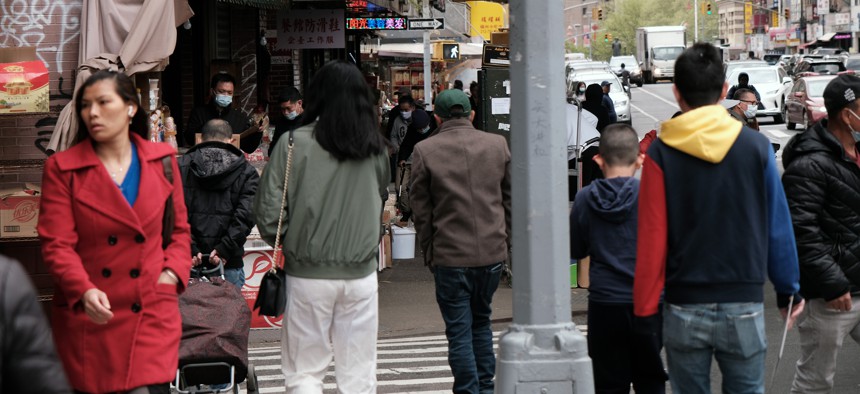Report: 61% of Asian Americans who have had an abortion experienced at least one community related barrier
A study by the National Asian Pacific American Women's Forum and Ibis Reproductive Health captures the abortion experience amongst Asian Americans.

Manhattan's Chinatown. Photo by Spencer Platt/Getty Images
A new study conducted by the National Asian Pacific American Women's Forum and Ibis Reproductive Health, funded by the Society of Family Planning, reveals the challenges AANHPI women face when accessing reproductive healthcare, and specifically, medication abortion. The study, titled Medication abortion among Asian Americans, Native Hawaiians, and Pacific Islanders: Knowledge, access, and attitudes, examines abortion needs, attitudes, knowledge, access and experiences of Asian Americans, Native Hawaiians, and Pacific Islanders.
Conducted over two-years, the study used a mixed-methods approach to understand the vast differences in beliefs within the community. The study consisted of focus group discussions, in-depth interviews, and a nationally representative survey and was translated into Chinese, Korean, Vietnamese, Urdu and Bangla.
The study comes during a time where almost no research examines the reproductive healthcare of AANHPI communities.
While the abortion rate in New York City among Asian women is 13 per 1,000 women, which varies by Asian subgroup, the report found that sexual and reproductive health services, including abortion, was secretive and taboo within the AANHPI community. Because of the secretive nature concerning SRH topics, there is limited knowledge surrounding abortion methods and where to access care.
Some participants noted parents would often use scare tactics as a way to discourage premarital sex and reinforce values, such as getting married and having children.
The report found that because of the stigma related to sex outside of marriage, pregnancy and abortion, many felt isolated during their abortion. To make matters worse, there is a lack of available and accessible information, which resulted in decreased knowledge of these topics.
“There’s such a taboo in us even talking about [abortion]. If I had a greater…acceptance to freely talk about [it] then I probably would have had a better general understanding about what a medication abortion would have meant” said one participant in the study.
When it came to knowledge of abortion methods, participants overwhelmingly had little to no knowledge of medication abortion. Some have even shared that they thought the only available abortion method available was procedural abortions, in which they had negative imagery associated with the procedure.
Participants often felt “lost” about where to access reproductive healthcare and heavily relied on online information to guide them. About 47% of participants did not know where to access medication abortion if they needed it.
One participant stated, ““We looked on Google pretty extensively… I Googled like what are abortions like…Because I think there’s so much societal secrecy about them, it’s very painful actually just emotionally, that it’s so limited in information that I actually had no idea what really happened.”
Some general barriers AANHPI women faced when accessing abortion were high costs of abortion and lack of insurance coverage, limited appointment availability, lack of transportation, legal restrictions, wait times at the clinic and protestors outside of clinics. Aside from the general barriers, AANHPI participants noted facing specific community challenges to access, such as stigma, lack of family support, living with or near family members, and lack of Asian and NHPI language options at clinics. Sixty-one percent of AANHPI women who had a medication abortion reported experiencing at least one community related barrier when seeking abortion care.
Recommendations to improve access to abortion care included collecting and publishing more disaggregated data and research on sexual and reproductive healthcare for AANHPI subgroups, build and increase support for community based organizations and providers serving large immigrant limited-english proficient populations, normalize the experience of abortion as part of healthcare and ensure culturally competent care within the healthcare system.
